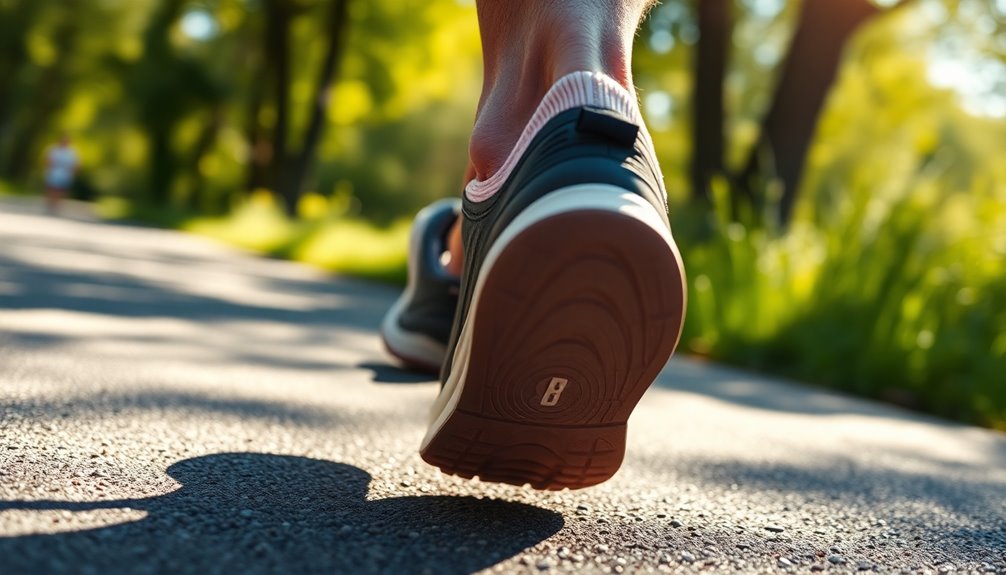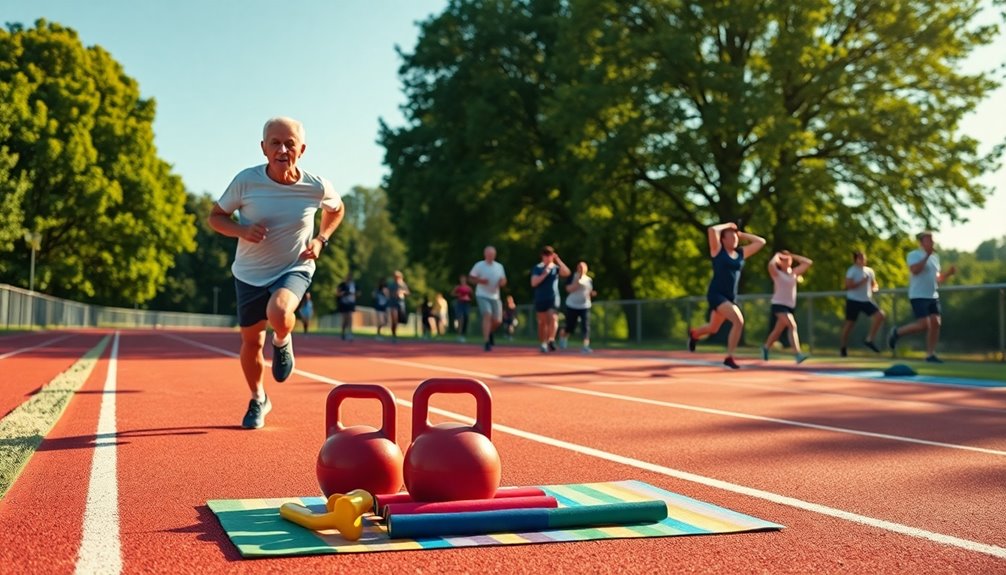As you age, it's crucial to adapt your running routine to stay injury-free. Strength training can enhance muscle mass and reduce injury risk, while dynamic flexibility exercises improve mobility. Listen to your body—persistent pain or unusual fatigue means it's time to rest. Incorporate cross-training for a balanced fitness regimen, and prioritize recovery practices like quality sleep and a nutritious diet. Discovering effective strategies can help you maintain your running passion without setbacks.
Key Takeaways
- Incorporate strength training into your routine to enhance muscle mass and reduce injury risk by up to 50%.
- Gradually increase running intensity and distance, following the 10% rule to avoid overexertion.
- Maintain a balance of 80% easy runs and 20% high-intensity workouts for optimal performance and injury prevention.
- Listen to your body; persistent pain or fatigue signals the need for rest and recovery.
- Regularly engage in dynamic flexibility exercises and stretching to improve joint mobility and prevent stiffness.
Understanding the Physiological Changes in Aging Runners

As you age, your body undergoes several physiological changes that can impact your running performance. Aging affects your cardiovascular function, leading to a decline in maximum heart rate and aerobic capacity, which can drop by about 7% each decade. You may also notice a decrease in muscle mass, particularly in key muscle groups like your calves, with concentric ankle power potentially reducing by nearly 48% between ages 20 and 80. These changes can increase your risk of injury, especially if you don't engage in strength training. Additionally, you might experience shorter stride lengths. To combat these effects, focus on maintaining a consistent training regimen, enhancing your strength, and adjusting your running mechanics to keep your performance strong and injury-free. Incorporating strength training into your routine can significantly help mitigate the risk of injury associated with these physiological changes.
The Impact of Biomechanics on Running Performance

Biomechanics plays an essential role in your running performance, especially as you age. As an older runner, you might notice a decrease in stride length and a need to increase your cadence to maintain speed.
Aging affects your range of motion, leading to more flexed knees at footstrike, which alters your biomechanics and can impact efficiency. Additionally, you may experience reduced peak propulsive forces, influencing your overall speed.
To combat these changes, focus on injury prevention strategies and adjust your training volume accordingly. Lifelong endurance running can enhance your cardiovascular performance, even into your 80s, so keep training smart to optimize your biomechanics and maintain a healthy running routine. Hydration as a key factor in supporting optimal performance is crucial as you continue to age.
Strengthening the Calf Muscles and Achilles Tendon

Strengthening your calf muscles and Achilles tendon is essential for maintaining running performance, especially as you age.
As you get older, muscle mass and force production in your calf muscles decline, making it vital to focus on strengthening exercises. Incorporating heavy slow resistance training can improve tendon stiffness, enhancing the spring-like properties of your Achilles tendon.
This not only boosts your running efficiency but also helps in preventing injuries like calf strains and Achilles tendinopathy. By prioritizing targeted exercise interventions to prevent these issues, you can maintain your strength and stay active longer. Additionally, regular grooming of your running shoes can help reduce wear and tear, which is crucial for injury prevention.
Make calf strength and tendon health a priority in your routine to continue enjoying the running you love while minimizing injury risks.
Effective Training Strategies for Older Runners

As an older runner, incorporating strength training into your routine can greatly reduce injury risk and help maintain muscle mass. It's also essential to gradually increase your running intensity and distance, sticking to the 10% rule to protect against overuse injuries. Additionally, engaging in activities that promote sensory processing skills can support your overall physical coordination and balance, further minimizing the risk of falls.
Strength Training Benefits
For veteran runners, incorporating strength training into your routine can be a game-changer. Not only does it help reduce running injuries by up to 50%, but it also preserves muscle mass and power, vital as you age.
Consider these key benefits of strength training:
- Improved calf muscle strength: Essential for maintaining running efficiency.
- Enhanced Achilles tendon stiffness: Supports better performance and reduces injury risks.
- Injury prevention: A consistent regimen can mitigate age-related declines in performance. Additionally, strength training promotes financial health by enabling runners to remain active and avoid costly medical expenses associated with injuries.
Gradual Intensity Increase
To maximize your running performance while minimizing the risk of injuries, it's crucial to gradually increase the intensity of your workouts. Aim for a gradual intensity increase of no more than 10% per week to help reduce your risk of overuse injuries, which can account for 50-75% of running-related issues.
Focus on maintaining a balance of 80% easy runs and 20% high-intensity workouts to enhance endurance and speed while keeping you injury-free. Incorporate strength training into your routine, as it can reduce injury rates by up to 50%.
Additionally, consider non-impact cross-training activities like cycling or swimming to complement your running and aid recovery, especially as your aerobic capacity changes with age. Staying informed about IRA investment strategies can further support your financial health as you age, ensuring you have the resources to maintain an active lifestyle.
Importance of Flexibility and Stretching Routines

As a veteran runner, you know that maintaining flexibility is essential to your performance and injury prevention. Incorporating dynamic flexibility exercises before your runs prepares your muscles and joints, while post-run stretching helps with recovery and mobility. Additionally, engaging in music therapy can enhance your emotional well-being and contribute to a more enjoyable running experience.
Dynamic Flexibility Exercises
While many runners focus on distance and speed, neglecting flexibility can lead to injuries and decreased performance.
Incorporating dynamic flexibility exercises, like lunges and leg swings, is essential for maintaining flexibility as you age. These exercises help improve joint mobility and prepare your muscles for action, which can considerably reduce the risk of injuries.
Here are some key benefits of dynamic stretching before your runs:
- Enhances muscle readiness for peak performance
- Increases joint mobility to support better running form
- Reduces the likelihood of strains in the Achilles tendon and calf muscles
Additionally, incorporating herbal alternatives like hibiscus can enhance skin elasticity, further supporting your overall performance as you age.
Post-Run Stretching Importance
Post-run stretching is essential for maintaining flexibility and preventing injuries, especially as you age. Regular post-run stretching helps combat the decreased elasticity of soft tissues, vital for preserving mobility.
Incorporating dynamic flexibility exercises like lunges and leg swings can enhance your comfort during runs. Stretching major muscle groups after running promotes blood flow and reduces muscle soreness, aiding recovery and restoring muscle length.
Don't overlook the importance of targeting the Achilles tendon; calf stretches, such as heel drops off a stair, specifically address stiffness that can develop with age. Additionally, maintaining good overall health can help reduce the risk of dental issues that may arise from poor habits, which can indirectly affect your running performance.
Injury Prevention Techniques for Veteran Runners

To keep injuries at bay, veteran runners should prioritize a structured warm-up routine before hitting the pavement. This prepares your muscles and joints, especially as flexibility declines with age.
Additionally, consider these injury prevention techniques:
- Gradually increase your running intensity and distance, following the 10% rule to avoid overuse injuries.
- Incorporate strength training focused on calf muscles and the Achilles tendon to maintain muscle mass and reduce risks of strains.
- Regularly assess your running form and consider professional gait analysis to correct any deficiencies.
Finally, invest in appropriate footwear and rotate between pairs to guarantee you have the right support. Additionally, maintaining a calm color palette in your running gear can help create a more peaceful mindset while you train.
Replace your shoes every 300-500 miles to keep running injuries at bay and enjoy your time on the road.
The Role of Cross-Training in Maintaining Fitness

Cross-training plays an essential role in maintaining fitness for veteran runners, offering a balanced approach to exercise that can enhance performance and reduce injury risk.
By incorporating activities like cycling and swimming, you can strengthen different muscle groups that aren't primarily engaged during running. This not only helps to maintain aerobic fitness but also allows your body to recover from the high-impact nature of running.
Additionally, cross-training enhances overall strength and flexibility, which are important for preventing injuries as you age. Research shows that diversifying your training routine can improve muscle balance and minimize repetitive stress injuries.
Many veteran runners who embrace cross-training report faster recovery times and fewer injuries, making it a significant strategy for longevity in the sport.
Listening to Your Body: Signs of Overexertion

While you may be enthusiastic to push your limits as a veteran runner, it's vital to listen to your body and recognize the signs of overexertion. Ignoring these signals can lead to injuries and hinder your long-term performance.
Pay attention to:
- Persistent pain during runs
- Unusual fatigue or prolonged soreness
- A decline in your performance
If you notice any of these signs, it's important to adapt your training regimen. Incorporating regular rest days allows your muscles to recover and reduces the risk of overexertion.
Prioritizing Recovery and Self-Care Practices

As you continue to hone your skills as a veteran runner, prioritizing recovery and self-care practices becomes essential for maintaining your performance and preventing injuries.
Incorporate effective recovery practices, like extended rest periods and quality sleep, to enhance healing. Regularly stretch before and after runs to boost your mobility and prevent injuries caused by decreased soft tissue elasticity.
Additionally, strength training focused on your core, hips, and legs can greatly aid injury prevention, reducing overuse injuries by up to 50%. Always listen to your body's signals, allowing extra recovery days as needed.
Finally, make sure your nutrition is on point, emphasizing a balanced diet rich in antioxidants to support tissue health and overall recovery.
Frequently Asked Questions
How to Stay Injury Free as a Runner?
To stay injury-free as a runner, you should gradually increase your distance and intensity by no more than 10% each week.
Incorporate strength training to bolster your core and lower body, which can greatly reduce injury risk.
Always engage in a proper warm-up and cool-down routine, and prioritize flexibility exercises to maintain joint mobility.
Finally, make sure you're wearing the right shoes and consider rotating them regularly for ideal comfort.
How Many Times a Week Should a 60 Year Old Run?
Did you know that runners over 60 can improve their cardiovascular health greatly by running just three to four times a week?
You should aim for that frequency, allowing your body to recover adequately between runs. Incorporating at least one or two rest or cross-training days helps you maintain overall fitness without overdoing it.
Focus on shorter distances, and listen to your body to adjust as needed for a sustainable routine.
Should a 70 Year Old Jog?
Absolutely, you can jog at 70! It's a great way to improve your cardiovascular health and boost your mood.
Just make sure you listen to your body. Start with shorter distances and gradually increase your intensity. Incorporating strength training will help you maintain muscle strength, too.
Always warm up and cool down properly to avoid injuries. Investing in good running shoes and checking your form can also keep you safe while enjoying your jogs.
How Can I Run Longer Without Getting Injured?
Imagine the sun rising as you lace up your shoes, ready for a longer run.
To avoid injuries, increase your mileage gradually—aim for no more than 10% each week.
Strength training keeps you strong, focusing on your calves and Achilles.
Always warm up and cool down, feeling the stretch in your muscles.
Cross-train with cycling or swimming for variety, and listen to your body; recovery is key to enjoying those peaceful runs.
Conclusion
As you embrace running in your later years, remember that about 40% of older runners experience injuries each year. By understanding your body's changes, prioritizing strength and flexibility, and listening to its signals, you can greatly reduce your risk. Incorporating cross-training and recovery practices will help keep you on the trails longer. Stay proactive about your health, and enjoy the freedom of running without the burden of injury!









